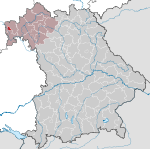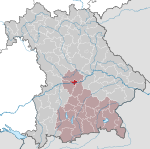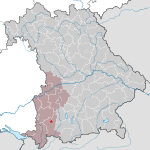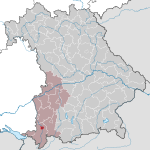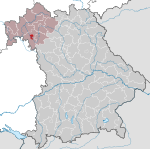List of coats of arms in Bavaria
The list of coats of arms in Bavaria with their sub-lists, which can be reached via the navigation bar below, contains - sorted according to the administrative structure - the coat of arms of the Free State of Bavaria listed in Wikipedia . The Free State of Bavaria is divided into 71 districts and 25 independent cities.
Free State of Bavaria
Main article: Bavarian state coat of arms
| state | coat of arms | Comments |
|---|---|---|
Free State of Bavaria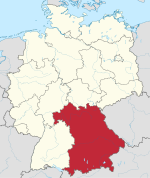
|
Large national coat of arms: Small national coat of arms: 
|
The Bavarian state coat of arms in its current form was introduced with the "Law on the Coat of Arms of the Free State of Bavaria" of June 5, 1950. The original version of the law came into force on December 8, 1946:
The design was created by Eduard Ege in 1945 . |
Districts
In contrast to the government districts of the same name and area , the Bavarian districts, as self-governing bodies, enjoy the right to have their own coats of arms and flags in accordance with Art to lead.
| district | coat of arms | Comments |
|---|---|---|
Upper Bavaria
|
 |
Approved by the State Ministry of the Interior on May 27, 1964 according to the decision of the District Assembly :
"Under the shield head with the Bavarian diamonds in black a red crowned and red armored golden lion." Karl Nikolaus Haas provided the design . |
Lower Bavaria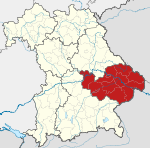
|
 |
Approved by the State Ministry of the Interior on September 24, 1957 according to the decision of the District Assembly:
“Split; in front the Bavarian diamonds, behind in silver a rising red panther. " Otto Hupp's design from 1904/05 already provided for today's coat of arms for Lower Bavaria, but with a blue, red-tongued panther. Although his design was published in 1912 as a district coat of arms, it was not officially valid. |
Upper Palatinate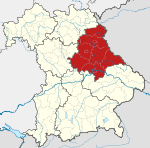
|
 |
Approved by the State Ministry of the Interior on August 25, 1960 according to the decision of the District Assembly:
“Split by a rising and curled red point, inside two diagonally crossed silver keys; in front in black a left-turning, red armored and red crowned golden lion, behind the Bavarian diamonds. " Karl Nikolaus Haas provided the design. |
Upper Franconia
|
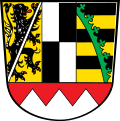 |
Approved by the State Ministry of the Interior on May 30, 1960 according to the decision of the District Assembly:
“Above a red shield base, in it three silver tips, split twice; in front, in gold, a left-facing, red-armored black lion covered with a silver sloping bar; Center quartered by silver and black; at the back divided five times by black and gold, covered with a sloping and curved green diamond ring. " Karl Nikolaus Haas provided the design. |
Middle Franconia
|
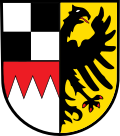 |
Approved by the State Ministry of the Interior on July 3, 1957 according to the decision of the District Assembly:
“Split and divided in front; in front above square of silver and black, below three silver tips in red; at the back in gold at the slit a red armored, black eagle. " |
Lower Franconia
|
 |
Approved by the State Ministry of the Interior on November 9, 1961 according to the decision of the District Assembly:
“Under the red head of a shield, in it three silver tips, split by blue and red; in front a slanting standard on a golden lance, quartered by silver and red and notched twice, behind a six-spoke silver wheel. " The coat of arms corresponds to a design published in 1906 by Otto Hupp. |
Swabia
|
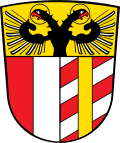 |
Approved by the State Ministry of the Interior on October 15, 1965 according to the decision of the District Assembly:
“Under a golden shield head, inside a growing, red armored and gold nimbed black double-headed eagle, split; at the front split by red and silver, at the back five times at an angle to the left split by silver and red, covered with a golden pole. " |
One district cities
| city | coat of arms | Comments |
|---|---|---|
| On the mountain |

|
Coat of arms tour since the 14th century:
"Divided; above in black a growing, red crowned and red armored golden lion, below the Bavarian diamonds. " |
| Ansbach |

|
The use of coat of arms since the 14th century, evidenced by the use of seals since 1393:
"A silver inclined wave bar in green, covered with three blue fish swimming one behind the other." |
| Aschaffenburg |

|
Coat of arms since the 13th century. King Ludwig I confirmed the coat of arms on April 1, 1836 in the form of the oldest seal image. The colors have been fixed since 1839:
“In silver, a red castle with round side towers and blue roofs; in the cloverleaf-shaped archway St. Martin, enthroned, clad in blue, with a silver pallium and blue miter, his right hand raised in blessing, with his left hand holding the golden crook. " |
| augsburg |

|
The coat of arms is derived from the seal image; Seal guide known since the 13th century. Current version since 1811:
"In a shield split by red and silver, a green stone pine nut on a golden capital, which is covered with a crowned head." For some time now, the city of Augsburg has used the coat of arms without the golden head. |
| Bamberg |

|
Coat of arms management since the 13th century; documented from seal management since 1279. Current version approved by the city council on May 28, 1953:
“In red a standing knight in silver armor with a red cross on his chest and a silver long sword on his belt; in the right a lance with a silver flag, on it a red cross, the left leaning on a blue shield with a silver eagle. " |
| Bayreuth |

|
Awarded by Margrave Albrecht Achilles of Brandenburg with a privilege of December 22, 1457; evidenced by seal management since 1429:
“Quartered and covered with two diagonally crossed rods, the right one black, the left one silver; 1 and 4 again quartered by silver and black; 2 and 3 in gold with a border decorated with red and silver, a red crowned and red armored black lion. " From 1819 to 1840 the Zollernvierung showed the colors silver and blue, the lion was red in a black field. |
| Coburg |

|
Coat of arms since the 13th century, evidenced by seal management since 1272:
"In gold, a black moor's head with a gold earring." Changes to the coat of arms: In the 13th century a battlement wall with a tower, flanked by a house and a hen. In the 14th century, twice the lion of Meissen and Thuringia in the quartered shield. From 1934 to 1945 the Mohrenkopf was replaced by an SA dagger with a swastika in the pommel. |
| gain |

|
Awarded by Margrave Christian Ernst von Brandenburg-Kulmbach in 1707, confirmed by a document issued by the government of Middle Franconia on March 14, 1972:
“Divided and split above; in front in silver a golden crowned and reinforced, red-tongued red eagle with golden clover stems and a breastplate embroidered in silver and black; behind, in silver, a gold crowned and armored, red-tongued black eagle with a gold neck crown, clover stems and the gold capital letters E and S on the chest; below, growing in blue over a silver battlement wall, a double-tailed, golden crowned, red-tongued golden lion. " |
| Fuerth |

|
The use of coats of arms since the 16th century, evidenced by the use of seals since 1562. Awarded in 1818, amended by decree on March 13, 1939:
"In silver a three-leaf clover leaf." Changes to the coat of arms: 1723 three stalked clovers on Dreiberg, after 1792 with the Brandenburg eagle. 1818 to 1939 with a green oak branch. |
| court |
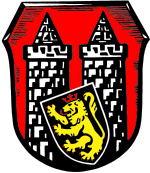
|
Coat of arms since the 14th century, evidenced by seal management since 1335:
“In red, two silver tin towers with pointed roofs; On top of them a black shield leaning against them, in it a red crowned and red armored golden lion. " Changes to the coat of arms: Since 1571, two wild men and an angel standing behind the lion's shield appear. From 1820 to 1840 the two towers were connected with a gable. Re-adoption of the old coat of arms in 1960, confirmed by a ministerial resolution of June 10, 1960. |
| Ingolstadt |

|
Coat of arms since the 13th century. The coat of arms is handed down in the seal; Seal guide documented since 1294; Seal with the panther only since about 1340:
"In silver, a fire-breathing blue panther." |
| Kaufbeuren |

|
Coat of arms since the 13th century, evidenced by the use of seals since 1295. The coat of arms has been handed down in its current form since 1449. Awarded by a ministerial resolution of the Ministry of the Interior on June 23, 1926:
“Split by gold and red; at the front of the gap a half black eagle, at the back a golden sloping bar separated from two six-pointed golden stars. " Coat of arms changes: From 1818 to 1892 the eagle was missing. |
| Kempten (Allgäu) |

|
Coats of arms since the 14th century, evidenced by seals since 1379. Awarded January 5, 1819:
“Split; of black and silver; at the front at the gap a half golden eagle, behind on a green three-mountain a red pinnacle tower with an open gate. " Coat of arms changes: 1488 split of gold and black, covered with the double-headed eagle in mixed up colors. |
| Landshut |

|
Coat of arms since the 13th century. The coat of arms is handed down in the seal; Seal management since 1275 shows:
"In silver three, two-to-one, blue iron hats with intertwined red storm straps." |
| Memmingen |

|
The use of coat of arms since the 13th century, evidenced by the use of seals since 1286:
“Split; in front in gold a half, red armored black eagle at the slit, behind in silver a continuous red paw cross. " |
| Munich |

|
Coat of arms management since the 13th century; the small coat of arms has been documented since 1304 and, according to the city council resolution of December 17, 1957, is the only city coat of arms:
Small coat of arms: “In silver, a standing monk with a gold bordered black robe and hood and red shoes, who holds a red book in his left hand; raised the right in blessing. " Large coat of arms : “In silver, an open red city gate between two red tin towers with roofs that are zigzagged with multiple bands of black and gold; above a growing, golden crowned and armored golden lion; in the gate of the monk of the little coat of arms. " The large city coat of arms is used exclusively for representative purposes. |
| Nuremberg |

|
Coat of arms tour since the 13th century:
Small coat of arms: “Split; in front in gold a half, red-tongued and gold-armored black eagle at the slit, in the back divided diagonally five times by red and silver. " Large coat of arms : "In blue a golden eagle with a pointed, golden crowned king's head." |
| Passau |

|
Coat of arms since the 13th century. The coat of arms is handed down in the seal; Seal management since 1368 proves:
"In silver, a soaring red wolf." |
| regensburg |
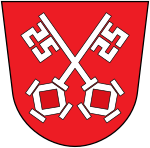
|
Coat of arms since the end of the 13th century. The coat of arms is derived from the seal image; Seal guiding since the late 12th century shows:
"Two slanted silver keys in red." |
| Rosenheim |

|
Coat of arms management since the 14th century. The coat of arms is handed down in the seal; Seal management since 1374 reliably proven:
"In red a silver heraldic rose with a golden lug and green sepals." |
| Schwabach |

|
Coat of arms since the 14th century, evidenced by the use of seals since 1329, confirmed by ministerial resolution of July 1, 1953:
"In red on a silver arch, a silver tin tower covered with blue, on the right side by a golden shield, inside a red armored black eagle, left by a blue shield, inside a red armored golden lion between golden shingles." Coat of arms changes: 1371 two beer pots and the Zollernvierung. In the 15th century, the castle count's lion, the Zollernvierung and the two beer taps. 1806 instead of the castle count's lion the Palatinate-Bavarian diamond, instead of the Zollernvierung the Bavarian diamond. |
| Schweinfurt |

|
The use of coat of arms since the 13th century, evidenced by the use of seals since 1309:
"A silver eagle in blue." |
| Straubing |

|
Coat of arms since the 13th century. The coat of arms is handed down in the seal; Seal guidance documented since the late 13th century; renewed 1952:
“In red a silver plow; Above one another two labels with Bavarian diamonds, below a golden heraldic lily. " |
| Pastures idOPf. |

|
Awarded by Elector Ludwig V and Count Palatine Friedrich II of the Electoral Palatinate with a coat of arms of January 25, 1510:
“Divided and split above; in front in black a red crowned, red armored golden lion, behind the Bavarian diamonds; below in red on a green three-mountain a green pasture. " |
| Wurzburg |

|
The use of coat of arms since the 12th century, evidenced by the use of seals since 1195:
"In black an inclined, notched flag, quartered in red and gold, on a silver lance pole." |
Counties
| district | coat of arms | Comments |
|---|---|---|
Aichach-Friedberg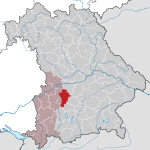
|
 |
According to the decision of the district council approved by the government of Swabia on December 10, 1975:
“Under the shield head with the Bavarian diamonds split by silver and red; in front a green oak leaf, behind a gold Ulrich cross. " |
Altötting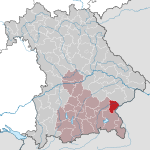
|
 |
Approved by the State Ministry of the Interior on March 17, 1960 by decision of the district council. After the district reform of 1972, the district council of the newly formed district decided to continue the coat of arms of the previous district unchanged, approved on August 23, 1972 by the government of Upper Bavaria:
“Split; in front, in blue, the silver octagon of the Altöttingen Chapel of Mercy, floating above it a golden crown of Mary; behind the Bavarian diamonds. " |
Amberg-Sulzbach
|
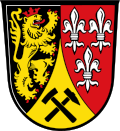 |
After the decision of the district council approved on August 17, 1973 by the government of the Upper Palatinate:
“Through a looped, sunken golden tip, crossed diagonally inside a black mallet and a black hammer, split by black and red; in front a left-turning, red crowned and red armored golden lion, behind three, two to one, silver lilies. " |
Ansbach
|
 |
After the decision of the district council approved on July 24, 1979 by the government of Central Franconia:
“Through a looped, sunken golden tip, crossed diagonally inside a black mallet and a black hammer, split by black and red; in front a left-turning, red crowned and red armored golden lion, behind three, two to one, silver lilies. " |
Aschaffenburg
|
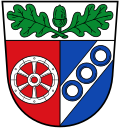 |
Approved by the State Ministry of the Interior on July 25, 1967 according to the decision of the district council. After the district reform of 1972, the district council of the newly formed district decided to continue the coat of arms of the previous district unchanged, approved on November 14, 1974 by the government of Lower Franconia:
“Under a silver shield head, inside two green oak leaves with a green acorn, split by red and blue; in the front a six-spoke silver wheel, behind a silver oblique left-hand bar covered with three blue rings. " |
augsburg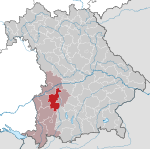
|
 |
According to the decision of the district council approved by the government of Swabia on May 15, 1975:
“Under a shield head split by red and silver, split by silver and blue; in front a red Ulrich cross, behind a golden lily. " |
Bad Kissingen
|
 |
According to the decision of the district council approved by the government of Lower Franconia on May 29, 1973:
“Under the blue head of a shield, split with three silver bowl wells; in front above a shield base made of red and silver in gold, a growing, red armed, black double-headed eagle at the gap, behind in silver a black paw cross. " |
Bad Toelz-Wolfratshausen
|
 |
Following a resolution of the district council approved by the government of Upper Bavaria on February 27, 1974:
“Under the blue head of a shield, in it a striding, red-tongued and red-armored golden lion, split; in front the Bavarian diamonds, behind in red two diagonally crossed silver abbot's bars with the curves facing. " |
Bamberg
|
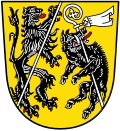 |
Approved by the State Ministry of the Interior on June 18, 1962 by decision of the district council. After the district reform of 1972, the district council of the newly formed district decided to continue the coat of arms of the previous district unchanged, approved on May 28, 1973 by the government of Upper Franconia:
"In gold next to each other a left-turned, red-armored black lion covered with a silver sloping left-hand bar and a soaring, resisting, red-tongued black boar, who holds a continuous, inclined silver abbot's staff with a silver handkerchief in the frail (mouth) and with the left front hammer ( Leg). " |
Bayreuth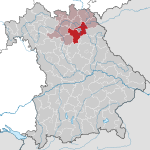
|
 |
Approved by the State Ministry of the Interior on September 27, 1962 by decision of the district council. After the district reform of 1972, the district council of the newly formed district decided to continue the coat of arms of the previous district unchanged, approved on February 21, 1974 by the government of Upper Franconia:
"Under a shield head with the Bavarian diamonds in silver, a golden armored red eagle with golden clover stems on the wings." |
Berchtesgadener Land
|
 |
Approved by the government of Upper Bavaria on May 29, 1973 according to the decision of the district council:
“Above the shield base with the Bavarian diamonds split by gold and blue; in front a red armored black lion, behind diagonally crossed a golden and a silver key. " |
Cham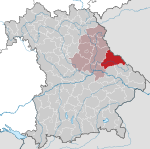
|
 |
Approved by the State Ministry of the Interior on August 17, 1962 according to the decision of the district council. After the district reform of 1972, the district council of the newly formed district decided to continue the coat of arms of the previous district unchanged, approved on December 9, 1975 by the government of the Upper Palatinate:
"Under the shield head with the Bavarian diamonds in red, the two-towered silver church of Chammünster in side view." |
Coburg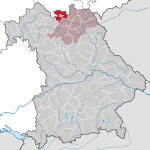
|
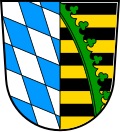 |
Approved by the State Ministry of the Interior on July 23, 1962 according to the decision of the district council. After the district reform of 1972, the district council of the newly formed district decided to continue the coat of arms of the previous district unchanged, approved on May 23, 1973 by the government of Upper Franconia:
“Split; in front the Bavarian diamonds, in the back divided nine times by black and gold, covered with a diagonal green diamond wreath. " |
Dachau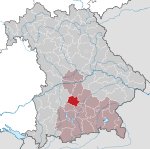
|
 |
Approved by the State Ministry of the Interior on July 10, 1954 according to the decision of the district council. After the district reform of 1972, the district council of the newly formed district decided to continue the coat of arms of the previous district unchanged, approved on July 15, 1976 by the government of Upper Bavaria:
"Under the shield head with the Bavarian diamonds in silver a red zigzag bar." |
Deggendorf
|
 |
Approved by the State Ministry of the Interior on September 17, 1963 by decision of the district council. After the district reform of 1972, the district council of the newly formed district decided in 1973 to continue the coat of arms of the previous district unchanged, approved on May 25, 1973 by the government of Lower Bavaria:
"In gold, a lowered blue wavy bar, above a red armed black double-headed eagle, below a green three-mountain." |
Dillingen on the Danube
|
 |
Approved by the district council on 19./25. October 1973 by the government of Swabia:
“Under the blue head of a shield, in it a striding golden lion, divided by gold and blue; above a striding, red armored black lion, below a golden lily. " |
Dingolfing-Landau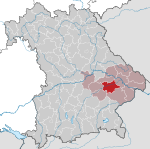
|
 |
After the decision of the district council approved on October 1, 1974 by the government of Lower Bavaria:
"Divided; above in gold a growing black eagle armed in red; Split at the bottom, in front a golden St. Andrew's cross in red, behind the Bavarian diamonds. " |
Danube Ries
|
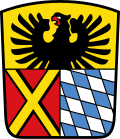 |
According to the decision of the district council approved by the government of Swabia on April 27, 1977:
“Split under the shield head with the Bavarian diamonds; in front in red a silver lion, which rises on a silver side four-mountain, in the back in the notch section three times divided by red and silver. " |
Ebersberg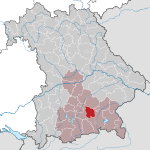
|
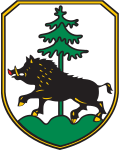 |
Approved by the State Ministry of the Interior on October 31, 1955 according to the decision of the district council. After the district reform of 1972, the district council of the newly formed district decided to continue the coat of arms of the previous district unchanged, approved on November 10, 1972 by the government of Upper Bavaria:
"In silver on a green three-mountain, a striding, gold-armored black boar, behind which a green fir with 29 branches grows." |
Eichstatt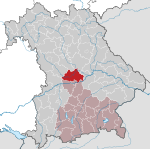
|
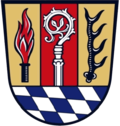 |
According to the decision of the district council approved by the government of Upper Bavaria on November 22, 1974:
“Above the base of the shield with the Bavarian diamonds in gold, a red post covered with a growing silver bishop's staff; in front a red torch on a black pipe, behind a vertical black stag pole. " |
Erding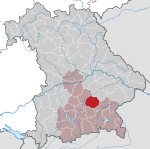
|
 |
Approved by the State Ministry of the Interior on October 9, 1953 according to the decision of the district council. After the district reform of 1972, the district council of the newly formed district decided to continue the coat of arms of the previous district unchanged, approved on October 31, 1972 by the government of Upper Bavaria:
"Under the shield head with the Bavarian diamonds in silver a jumping, golden-armored red horse." |
Erlangen-Höchstadt
|
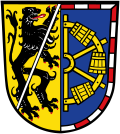 |
After the decision of the district council approved on August 19, 1976 by the government of Central Franconia:
“Split; in front, in gold, a black lion turned to the left, covered with a silver sloping left-hand bar and reinforced with red; behind in blue with a border decorated with red and silver, half a golden water paddle. " |
Forchheim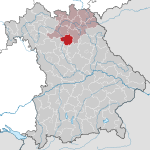
|
 |
According to the decision of the district council approved on March 7, 1974 by the government of Upper Franconia:
“Above a silver shield base, in it a red fish, split by gold and red; in front a left-facing, red-armored black lion covered with a silver sloping left bar; behind an inclined silver key. " |
Freising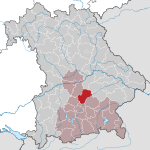
|
 |
Approved by the State Ministry of the Interior on August 21, 1954 according to the decision of the district council. After the district reform of 1972, the district council of the newly formed district decided to continue the coat of arms of the previous district unchanged, approved on July 15, 1976 by the government of Upper Bavaria:
“Under the shield head with the Bavarian diamonds split by gold and red; in front a left-turning, red crowned moor's head with a red earring, behind a heraldic silver rose. " |
Freyung-Grafenau
|
 |
After the decision of the district council approved by the government of Lower Bavaria on March 9, 1976:
"Above a shortened and looped point, inside the Bavarian diamonds, in silver next to each other a black bear turned to the left and a red wolf." |
Fürstenfeldbruck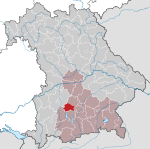
|
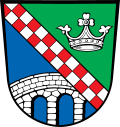 |
Approved by the State Ministry of the Interior on November 15, 1967 according to the decision of the district council. After the district reform of 1972, the district council of the newly formed district decided to continue the coat of arms of the previous district unchanged, approved on November 11, 1976 by the government of Upper Bavaria:
“By a sloping beam made of silver and red in two rows divided by green and blue; above a silver prince's crown, below a three-arched, brick-built silver bridge. " |
Fuerth
|
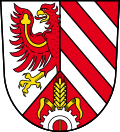 |
Approved by the State Ministry of the Interior on June 18, 196 according to the decision of the district council. After the district reform of 1972, the district council of the newly formed district decided to continue the coat of arms of the previous district unchanged, approved on November 20, 1972 by the government of Middle Franconia:
“Above a shortened red tip, in it a vertical golden ear of wheat, on top of which a silver cogwheel growing from the lower edge of the shield, split; in front in silver half a red eagle with gold armor at the slit, with a golden clover stem on the wing, in the back divided diagonally five times by red and silver. " |
Garmisch-Partenkirchen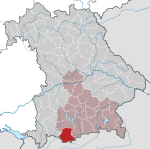
|
 |
Approved by the State Ministry of the Interior on September 11, 1962 according to the decision of the district council. After the district reform of 1972, the district council of the newly formed district decided to continue the coat of arms of the previous district unchanged, approved on November 20, 1972 by the government of Upper Bavaria:
“Above a shortened and looped point, inside the Bavarian diamonds, split by silver and gold; in front a red griffin lion turned to the left, behind a red crowned moor's head with a red earring. " |
Gunzburg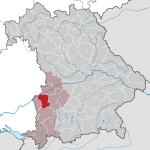
|
 |
After the decision of the district council approved on April 19, 1973 by the government of Swabia:
“Split; in front in red a half silver eagle at the slit; in the back five times at an angle to the left divided by silver and red, covered by a golden pole. " |
Hatred Mountains
|
 |
After the decision of the district council approved on August 1, 1974 by the government of Lower Franconia:
“Above a shield base, divided by black and gold and covered with a green diamond wreath, split by red and gold; in front three lowered silver tips, behind a red armored black lion covered with a silver sloping bar. " |
court
|
 |
Approved by the State Ministry of the Interior on February 19, 1963 by decision of the district council. After the district reform of 1972, the district council of the newly formed district decided to continue the coat of arms of the previous district unchanged, approved on February 22, 1977 by the government of Upper Franconia:
“Split; in front, in black, a golden lion turned to the left, crowned in red and armored in red; in the back in gold with a border decorated with red and silver, a red armored black lion. " |
Kelheim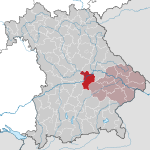
|
 |
Approved by the State Ministry of the Interior on October 14, 1960 by decision of the district council. After the district reform of 1972, the district council of the newly formed district decided to continue the coat of arms of the previous district unchanged, approved on October 31, 1975 by the government of Lower Bavaria:
“Split under the shield head with the Bavarian diamonds; divided in front by silver and blue with three, two to one, heraldic roses in mixed up colors; at the back diagonally divided by silver and black. " |
Kitzingen
|
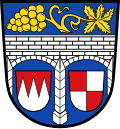 |
According to the decision of the district council approved by the government of Lower Franconia on October 23, 1974:
“In blue under a piece of golden vine, a silver stone bridge with two arches; under the front arch a red label with three silver tips inside, under the rear arch a small label crossed in red and silver. " |
Kronach
|
 |
Approved by the State Ministry of the Interior on April 11, 1957 according to the decision of the district council. After the district reform of 1972, the district council of the newly formed district decided to continue the coat of arms of the previous district unchanged, approved on June 5, 1973 by the government of Upper Franconia:
“Split by a lowered, rising and curled blue tip, inside a golden water wheel; in front in gold a left-facing, red armored black lion covered with a silver sloping bar, behind in a golden field sprinkled with red hearts a red crowned and red armored black lion. " |
Kulmbach
|
 |
After the decision of the district council approved on August 28, 197 by the government of Upper Franconia:
“By a lowered, curled point, square in black and silver, split by gold and blue; in front a red armored, black lion turned to the left, covered with a silver sloping left bar, behind a red armored, silver eagle. " |
Landsberg am Lech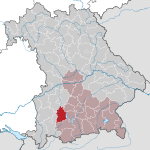
|
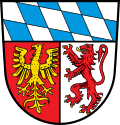 |
Approved by the State Ministry of the Interior on October 9, 1953 according to the decision of the district council. After the district reform of 1972, the district council of the newly formed district decided to continue the coat of arms of the previous district unchanged, approved on October 3, 1972 by the government of Upper Bavaria:
“Under the shield head with the Bavarian diamonds split by red and silver; in front a golden eagle, behind a red lion. " |
Landshut
|
 |
Approved by the State Ministry of the Interior on August 25, 1960 by decision of the district council. After the district reform of 1972, the district council of the newly formed district decided to continue the coat of arms of the previous district unchanged, approved on May 23, 1973 by the government of Lower Bavaria:
"Under the shield head with the Bavarian diamonds in red a silver wall with two battlements." |
Lichtenfels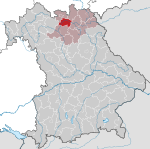
|
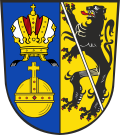 |
After the decision of the district council approved by the government of Upper Franconia on July 1, 1977:
“Split by blue and gold; in front above a golden orb, a golden imperial crown with red lining; behind a red armored, black lion covered with a silver sloping bar. " |
Lindau (Lake Constance)
|
 |
After the decision of the district council approved on April 14, 1978 by the government of Swabia:
"Under the shield head with the Bavarian diamonds in silver above a blue wavy bar next to each other a green linden tree and a three-lipped red flag with gold fringes and three red rings." |
Main-Spessart
|
 |
After the decision of the district council approved on December 16, 1974 by the government of Lower Franconia:
“A narrow silver wave pole in red; in front above a six-spoke silver wheel a golden oak leaf with two golden acorns; behind three silver tips a bunch of golden grapes. " |
Miesbach
|
 |
Approved by the State Ministry of the Interior on September 15, 1955 by decision of the district council. After the district reform of 1972, the district council of the newly formed district decided to continue the coat of arms of the previous district unchanged, approved on June 7, 1977 by the government of Upper Bavaria:
"In silver above a half, gold-armored red eagle with outstretched wings over two diagonally crossed red bars, below over blue water waves two green sea leaves crossed with the stems." |
Miltenberg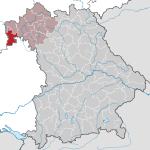
|
 |
According to the decision of the district council approved by the government of Lower Franconia on May 25, 1977:
“Under the shield head with the Bavarian diamonds in red a silver wave pole; in front of it a six-spoke silver wheel; behind three silver tips. " |
Mühldorf am Inn
|
 |
Approved by the State Ministry of the Interior on April 24, 1968 by decision of the district council. After the district reform of 1972, the district council of the newly formed district decided to continue the coat of arms of the previous district unchanged, approved on March 15, 1973 by the government of Upper Bavaria:
“Split by black and gold; in front a left-facing, red crowned and red armored golden lion, behind a red armored black lion. " |
Munich
|
 |
Approved by the State Ministry of the Interior on April 3, 1957 according to the decision of the district council. After the district reform of 1972, the district council of the newly formed district decided to continue the coat of arms of the previous district unchanged, approved on August 8, 1972 by the government of Upper Bavaria:
“Split; in front the Bavarian diamonds, in the back divided by black and gold, covered as a whole with a slanting silver wavy bar. " |
Neuburg-Schrobenhausen
|
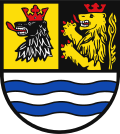 |
Approved by the government of Upper Bavaria on June 12, 1974 according to the decision of the district council:
"Divided; above split by gold and black, in front a red-tongued and red-crowned black bear's head, behind a red-armored and red-crowned growing golden lion; below in silver two blue wavy bars. " |
Neumarkt in the Upper Palatinate
|
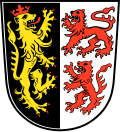 |
Approved by the State Ministry of the Interior on February 8, 1960 by decision of the district council. After the district reform of 1972, the district council of the newly formed district decided to continue the coat of arms of the previous district unchanged, approved on October 8, 1974 by the government of the Upper Palatinate:
“Split by black and silver; in front a golden lion turned to the left, armored in red and crowned in red; behind each other two red lions, the upper one striding, the lower one erect. " |
Neustadt an der Aisch-Bad Windsheim
|
 |
After the decision of the district council approved on June 14, 1974 by the government of Central Franconia:
“Split over a shield base split seven times by silver and blue; in front in gold a red-tongued brackish head square in silver and black, behind in silver a half, red-armed black eagle at the gap. " |
Neustadt an der Waldnaab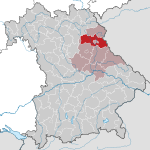
|
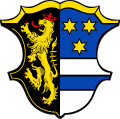 |
Approved by the State Ministry of the Interior on December 22, 1954, following a decision by the District Council. After the district reform of 1972, the district council of the newly formed district decided to continue the coat of arms of the previous district unchanged, approved on March 22, 1977 by the government of the Upper Palatinate:
“Split and divided behind; in front in black a red crowned and red armored golden lion; in the back above in blue three, two to one, gold stars, below in silver a blue bar. " |
New Ulm
|
 |
Approved by the State Ministry of the Interior on July 13, 1966 according to the decision of the district council. After the district reform of 1972, the district council of the newly formed district decided to continue the coat of arms of the previous district unchanged, approved on January 7, 1975 by the government of Swabia:
"Above a red shield base, inside a horizontal, gold-studded, silver horn, divided five times at an angle to the left by red and silver, covered with a black-clad and golden-crowned moor, who is holding a golden bishop's hat in her hands." |
Nuremberg country
|
 |
According to the decision of the district council approved by the government of Central Franconia on October 1, 1974:
“Above a blue shield base, in it a silver mill wheel below, split; in front in gold a red-armored half black eagle at the gap, in the back divided diagonally five times by red and silver. |
Oberallgäu
|
 |
After the decision of the district council approved on November 23, 1973 by the government of Swabia:
“Split by red and gold; in front under the shield head divided by red and blue a growing, silver rock mountain, behind one another three striding, looking, red armored black lions. " |
Ostallgäu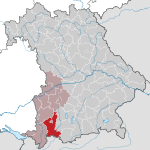
|
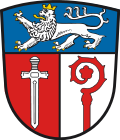 |
According to the decision of the district council approved by the government of Swabia on October 8, 1974:
“Under a blue head of a shield, in it a striding, golden crowned and golden armored silver lion, split by red and silver; in front a fallen silver sword, behind a growing red abbot's staff. " |
Passau
|
 |
According to the decision of the district council approved by the government of Lower Bavaria on June 27, 1974:
"Above a shield base with the Bavarian diamonds in silver, a red wolf and a red panther turned to the left." |
Pfaffenhofen on the Ilm
|
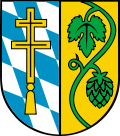 |
Approved by the State Ministry of the Interior on April 18, 1963 by decision of the district council. After the district reform of 1972, the district council of the newly formed district decided to continue the coat of arms of the previous district unchanged, approved on July 4, 1974 by the government of Upper Bavaria:
“Split; in front the Bavarian diamonds, covered with a double-armed golden cross; behind in gold a continuous green hop vine with leaf and umbel. " |
rain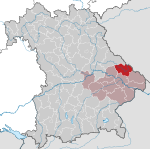
|
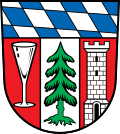 |
After the decision of the district council approved on July 9, 1975 by the government of Lower Bavaria:
“Under the shield head with the Bavarian diamonds in red, a silver post, inside a green spruce rooted; in front a silver goblet, behind a growing tin tower. " |
regensburg
|
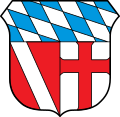 |
Approved by the State Ministry of the Interior on September 17, 1963 by decision of the district council. After the district reform of 1972, the district council of the newly formed district decided to continue the coat of arms of the previous district unchanged, approved on September 26, 1972 by the government of the Upper Palatinate:
“Under the shield head with the Bavarian diamonds split by red and silver; in front a silver sloping bar, behind a continuous straight arm red paw cross. " |
Rhön-Grabfeld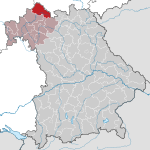
|
 |
After the decision of the district council approved on August 17, 1976 by the government of Lower Franconia:
“Divided by red and green by a raised silver wavy bar; above a golden crown of leaves, below on a silver three-mountain three silver crosses. " |
Rosenheim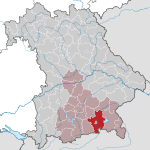
|
 |
Approved by the government of Upper Bavaria on May 14, 1976 according to the decision of the district council:
“Split under the shield head with the Bavarian diamonds; front split by silver and blue, covered with two sea leaves on stems crossed at an angle in mixed up colors, behind in silver a gold crowned and gold armored red lion. " |
Roth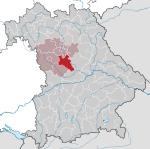
|
 |
After the decision of the district council approved by the government of Central Franconia on February 21, 1975:
“Split by a curled golden tip, inside a heraldic rose with a silver lug and silver sepals; in the front quartered in silver and black, in the back a growing silver bishop's staff in red. " |
Rottal Inn
|
 |
After the decision of the district council approved by the government of Lower Bavaria on October 19, 1973:
“Divided by silver and gold by a narrow, blue sloping beam, pointing to the left; above a fire-breathing red panther hull, below a rising red horse directed to the left. " |
Schwandorf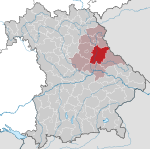
|
 |
According to the decision of the district council approved by the government of the Upper Palatinate on December 13, 1974:
“Split by black and silver; Above a lowered, narrow wavy bar split by silver and blue, underlaid by a cogwheel split by gold and black, in front a left-facing, red armored and red crowned golden lion, behind a red pinnacle tower. " |
Schweinfurt
|
 |
Approved by the State Ministry of the Interior on the decision of the district council. After the district reform of 1972, the district council of the newly formed district decided to continue the coat of arms of the previous district unchanged, approved on April 25, 1974 by the government of Lower Franconia:
"Above a red shield base, in it three silver tips, in gold a red armed, black eagle." |
Starnberg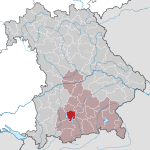
|
 |
Approved by the State Ministry of the Interior on March 17, 1960 by decision of the district council. After the district reform of 1972, the district council of the newly formed district decided to continue the coat of arms of the previous district unchanged, approved on October 24, 1972 by the government of Upper Bavaria:
"On top of the Bavarian diamonds, a striding golden lion, below a golden eagle." |
Straubing arch
|
 |
After the decision of the district council approved on April 8, 1974 by the government of Lower Bavaria:
“Divided by a silver wavy bar; above in green the silver clad and golden crowned Madonna from Bogenberg in a golden halo, flanked on the right by a slanting golden ear and on the left by a slanting left golden ear; below the Bavarian diamonds. " |
Tirschenreuth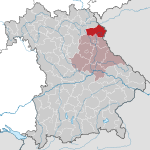
|
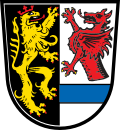 |
According to the decision of the district council approved by the government of the Upper Palatinate on March 1, 1974:
“Split by black and silver; in front a red crowned and red armored lion turned to the left, behind a red dragon's body over a lowered blue bar. " The district formed in 1972 from the earlier districts of Tirschenreuth and Kemnath took over the former district coat of arms of Tirschenreuth, changing the rear field. Only the body remained of the red kite, but the Leuchtenberg bar was taken as a picture from the earlier Kemnath district coat of arms, which also showed the Palatinate lion in the rear half of the shield. |
Traunstein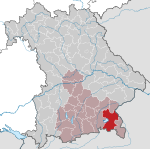
|
 |
Approved by the State Ministry of the Interior on March 21, 1955 by decision of the district council. After the district reform of 1972, the district council of the newly formed district decided to continue the coat of arms of the previous district unchanged, approved on May 14, 1976 by the government of Upper Bavaria:
“Split; in front in silver a striding, red armored and fire-breathing blue panther; divided behind by gold and red; above a red armored, black eagle, below on a green three-mountain a two-towered silver castle, behind which a green tree grows. " |
Unterallgäu
|
 |
According to the decision of the district council approved by the government of Swabia on September 12, 1974:
“With a curved, lowered point with the Bavarian diamonds split by black and gold; in front a golden rosette, behind a blue lily. " The design of the coat of arms comes from the monastery archivist and district home administrator Aegidius Kolb and the design was done by Rudolf Mussgnug from Nördlingen. |
Weilheim-Schongau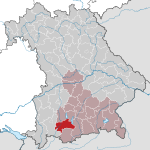
|
 |
According to the decision of the district council approved by the government of Upper Bavaria on May 21, 1974:
"Under a golden shield head, in it a striding, looking, red armored and red-tongued black lion, in blue a golden abbot's staff with a silver mallet and a silver hammer crossed diagonally underneath." |
Weissenburg-Gunzenhausen
|
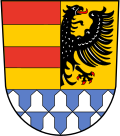 |
According to the decision of the district council approved on March 8, 1976 by the government of Central Franconia:
“Above the foot of the shield, in it monkshood of silver and blue, split; in front three times divided by red and gold, behind in gold a half, red armed black eagle at the gap. " |
Wunsiedel in the Fichtel Mountains
|
 |
According to the decision of the district council approved on July 26, 1974 by the government of Upper Franconia:
“Under a shield head quartered by silver and black, split by gold and red; in front a red-tongued black eagle at the crack; behind a silver deer antler. " |
Wurzburg
|
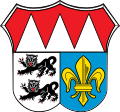 |
According to the decision of the district council approved by the government of Lower Franconia on December 13, 1974:
“Divided and split below; above three silver tips in red; below in front in silver two striding, looking, red armored black lions, behind in blue a golden lily. " |
References and comments
- HdBG
- Entry on the coat of arms in the database of the House of Bavarian History
- ↑ a b Article 1 of the Law on the Coat of Arms of the Free State of Bavaria (WappenG) of June 5, 1950
- ^ HdBG: Upper Bavaria
- ↑ HdBG: Lower Bavaria
- ^ HdBG: Upper Palatinate
- ↑ HdBG: Upper Franconia
- ^ HdBG: Middle Franconia
- ↑ HdBG: Lower Franconia
- ^ HdBG: Swabia
- ^ House of Bavarian History - Bavaria's municipalities. Retrieved May 12, 2020 .
- ^ House of Bavarian History - Bavaria's municipalities. Retrieved May 12, 2020 .
- ^ House of Bavarian History - Bavaria's municipalities. Retrieved May 12, 2020 .
- ^ House of Bavarian History - Bavaria's municipalities. Retrieved May 12, 2020 .
- ^ House of Bavarian History - Bavaria's municipalities. Retrieved May 12, 2020 .
- ^ House of Bavarian History - Bavaria's municipalities. Retrieved May 12, 2020 .
- ^ House of Bavarian History - Bavaria's municipalities. Retrieved May 12, 2020 .
- ^ House of Bavarian History - Bavaria's municipalities. Retrieved May 12, 2020 .
- ^ House of Bavarian History - Bavaria's municipalities. Retrieved May 12, 2020 .
- ^ House of Bavarian History - Bavaria's municipalities. Retrieved May 12, 2020 .
- ^ House of Bavarian History - Bavaria's municipalities. Retrieved May 12, 2020 .
- ^ House of Bavarian History - Bavaria's municipalities. Retrieved May 12, 2020 .
- ^ House of Bavarian History - Bavaria's municipalities. Retrieved May 12, 2020 .
- ^ House of Bavarian History - Bavaria's municipalities. Retrieved May 12, 2020 .
- ^ House of Bavarian History - Bavaria's municipalities. Retrieved May 12, 2020 .
- ^ House of Bavarian History - Bavaria's municipalities. Retrieved May 12, 2020 .
- ^ House of Bavarian History - Bavaria's municipalities. Retrieved May 12, 2020 .
- ^ House of Bavarian History - Bavaria's municipalities. Retrieved May 12, 2020 .
- ^ House of Bavarian History - Bavaria's municipalities. Retrieved May 12, 2020 .
- ^ House of Bavarian History - Bavaria's municipalities. Retrieved May 12, 2020 .
- ^ House of Bavarian History - Bavaria's municipalities. Retrieved May 12, 2020 .
- ^ House of Bavarian History - Bavaria's municipalities. Retrieved May 12, 2020 .
- ^ HdBG: Aichach-Friedberg district
- ^ HdBG: Altötting district
- ↑ HdBG: Amberg-Sulzbach district
- ^ HdBG: District of Ansbach
- ^ HdBG: Aschaffenburg district
- ^ HdBG: District of Augsburg
- ^ HdBG: Bad Kissingen district
- ^ HdBG: Bad Tölz-Wolfratshausen district
- ^ HdBG: Bamberg district
- ^ HdBG: Bayreuth district
- ^ HdBG: District of Berchtesgadener Land
- ^ HdBG: District of Cham
- ^ HdBG: District of Coburg
- ^ HdBG: District of Dachau
- ↑ HdBG: District Deggendorf
- ^ HdBG: District of Dillingen on the Danube
- ^ HdBG: District of Dingolfing-Landau
- ↑ HdBG: District of Donau-Ries
- ↑ HdBG: District Ebersberg
- ↑ HdBG: District of Eichstätt
- ^ HdBG: District of Erding
- ^ HdBG: District of Erlangen-Höchstadt
- ^ HdBG: Forchheim district
- ↑ HdBG: District of Freising
- ^ HdBG: Freyung-Grafenau district
- ^ HdBG: Fürstenfeldbruck district
- ↑ HdBG: Fürth district
- ^ HdBG: District of Garmisch-Partenkirchen
- ^ HdBG: District of Günzburg
- ↑ HdBG: District of Haßberge
- ↑ HdBG: District of Hof
- ↑ HdBG: District of Kelheim
- ^ HdBG: District of Kitzingen
- ^ HdBG: District of Kronach
- ^ HdBG: Kulmbach district
- ^ HdBG: Landsberg am Lech district
- ^ HdBG: Landshut district
- ^ HdBG: District of Lichtenfels
- ↑ HdBG: District of Lindau (Lake Constance)
- ^ HdBG: Main-Spessart district
- ^ HdBG: Miesbach district
- ^ HdBG: Miltenberg district
- ^ HdBG: District of Mühldorf am Inn
- ^ HdBG: District of Munich
- ^ HdBG: District of Neuburg-Schrobenhausen
- ^ HdBG: District of Neumarkt in the Upper Palatinate
- ^ HdBG: District Neustadt an der Aisch-Bad Windsheim
- ^ HdBG: District Neustadt an der Waldnaab
- ^ HdBG: District of Neu-Ulm
- ^ HdBG: District of Nürnberger Land
- ↑ HdBG: Oberallgäu district
- ^ HdBG: District of Ostallgäu
- ↑ HdBG: District of Passau
- ^ HdBG: Landkreis Pfaffenhofen an der Ilm
- ^ HdBG: District of Regen
- ^ HdBG: District of Regensburg
- ^ HdBG: District of Rhön-Grabfeld
- ↑ HdBG: District of Rosenheim
- ^ HdBG: District of Roth
- ↑ HdBG: Rottal-Inn district
- ^ HdBG: Schwandorf district
- ↑ HdBG: District of Schweinfurt
- ↑ HdBG: District of Starnberg
- ^ HdBG: District of Straubing-Bogen
- ^ HdBG: Tirschenreuth district
- ^ HdBG: Traunstein district
- ↑ HdBG: Landkreis Unterallgäu
- ^ HdBG: District of Weilheim-Schongau
- ^ HdBG: Weissenburg-Gunzenhausen district
- ^ HdBG: District of Wunsiedel in the Fichtelgebirge
- ^ HdBG: Würzburg district
See also
- List of places in Bavaria
- List of coats of arms in Germany
- List of coats of arms of the independent cities in Bavaria
- List of coats of arms with Bavarian diamonds
- List of coats of arms with the Palatinate lion


